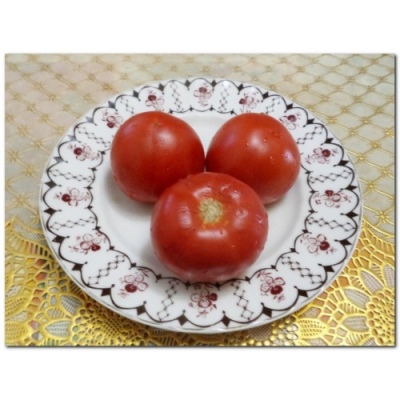
- Authors: Russia
- Name synonyms: Mercedes
- Category: grade
- Growth type: determinant
- Appointment: universal
- Ripening period: late ripening
- Bush height, cm: 80-100
- Leaves: conventional type
- Ripe fruit color: Red
- Fruit shape: rounded
Despite the fact that the tomato of the Mercedes variety is of Russian origin, it is quite rare on personal plots. This is an interesting late-ripening cocktail-type tomato with red fruits. Differs in a good harvest, appetizing appearance and pleasant, sweet-sour taste.
Breeding history
Mercedes is an old family tomato variety, bred in Russia, in Kursk. A synonym for the name is Mersedes. The variety got this name because of the extraordinary similarity between the sign of the car manufacturer of the same name and the "pattern" in the form of three rays at the top of the fruit.
Description of the variety
The Mercedes variety is a late tomato variety. It can be grown both under film shelters and in open ground.
A culture with a determinant growth rate. The plant is undersized. The bush is quite compact, 80-100 cm high. Leaves are of ordinary type. Builds up good green mass.
The inflorescences are simple. The brushes are not long. They usually form 6-7 red fruits. They are smooth, with a thick wall.
The variety has a universal purpose, ideal for canning and pickling, making lecho and tomato paste. Great for making sauces.
Possesses good transportability and keeping quality.
The main qualities of the fruit
Fruits are round in shape, cocktail type. Weight does not exceed 100 g. Ripe red fruit, red-orange stains near the stalk. The skin is thin. Inside there is a red, juicy pulp, 4 seed chambers, small seeds. Resistant to cracking. The main advantage of the variety is its long shelf life.
Taste characteristics
Very pleasant, balanced tomato flavor. Aftertaste - slightly sour taste. The seeds are small, slightly felt when consumed.
Ripening and fruiting
The ripening of the fruits of the Mercedes tomato is friendly. All fruits on one brush turn red almost simultaneously. Tomatoes begin to ripen in early August.
Yield
The variety is fruitful.
The timing of planting seedlings and planting in the ground
Seeds of tomatoes of the Mercedes variety are sown about 55-65 days before planting in a permanent place. You can calculate the time yourself. For this, approximately 60-65 days are counted before the spring frost ends. Disembarkation is carried out when the air temperature reaches a minimum of + 13 ... 15 ° C.
This tomato variety can also be grown in a seedless way. After the threat of the night temperature drop to minus values has passed, seeds can be sown in the ground.

Growing tomato seedlings is an extremely important process, because it largely depends on whether the gardener will be able to harvest at all. All aspects must be taken into account, from seedbed preparation to planting in the ground.
Landing scheme
Tomatoes are planted in prepared pits. If you pour water directly into the hole before planting, then after planting the plants can not be watered for 5-7 days. This time period will allow the plant to adapt to new conditions.
The distance between the bushes should be about 30-40 cm, between the rows 60-70 cm, and the row spacing is about 70-100 cm.

Growing and care
Tomatoes of this variety do not need pinching. If stepchildren appear, they are broken off. The only exception can be the stepson, which is formed under the upper inflorescence.
The plant needs to be tied to a support.
Mercedes is unpretentious in care. All agrotechnical measures are standard: weeding, loosening, application of organic or mineral fertilizers, watering.
Excessive watering should be avoided. Tomatoes do not tolerate high humidity. To avoid the appearance of diseases, they are watered only at the root. For irrigation, use warm, settled water. Watered no more than once a week, spend from 3 to 10 liters of water for each tomato bush.
In order for the tomatoes to tie evenly on the hands, shake them with your hands during flowering.




A plant needs different micronutrients at each stage of growth. All fertilizers can be divided into two groups: mineral and organic. Folk remedies are often used: iodine, yeast, bird droppings, eggshells.
It is important to observe the rate and period of feeding. This also applies to folk remedies and organic fertilizers.
Disease and pest resistance
Since the tomato belongs to late-ripening varieties, it is imperative to carry out timely treatment against late blight. Fungicides are used to protect the plant from this dangerous disease.


Growing regions
Due to the late ripening period, it is more suitable for growing outdoors in the southern regions of the country. In the rest, it is better to grow in a greenhouse.
Review overview
On gardening forums, you can find only flattering reviews about Mercedes tomatoes. The variety has earned a positive reputation for its flavor profile and long shelf life. Some growers manage to keep tomatoes of this variety for 9 months after harvest.

























































































